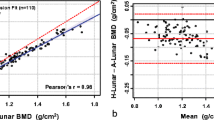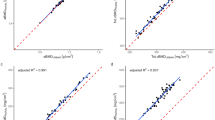Abstract
The purpose of this study was to investigate variations in bone density between 16 European populations, 13 of which were participants in the European Vertebral Osteoporosis Study (EVOS). Men and women aged 50–80 years were recruited randomly from local population registers, stratified in 5-year age bands. The other three centres recruited similarly. Random samples of 20–100% of EVOS subjects were invited for dual-energy X-ray absorptiometry (DXA) densitometry of the lumbar spine and/or proximal femur using Hologic, Lunar or Norland pencil beam machines or, in one centre, a Sopha fan-beam machine. Cross-calibration of the different machines was undertaken using the European Spine Phantom prototype (ESPp). Highly significant differences in mean bone density were demonstrated between centres, giving rise to between-centre SDs in bone density that were about a quarter of a population SD. These differences persisted when centres using Hologic machines and centres using Lunar machines were considered separately. The centres were ranked differently according to whether male or female subjects were being considered and according to site of measurement (L2–4, femoral neck or femoral trochanter). As expected, bone mineral density (BMD) had a curvilinear relationship with age, and apparent rates of decrease slowed as age advanced past 50 years in both sexes. In the spine, not only did male BMD usually appear to increase with age, but there was a highly significant difference between centres in the age effect in both sexes, suggesting a variability in the impact of osteoarthritis between centres. Weight was consistently positively associated with BMD, but the effects of height and armspan were less consistent. Logarithmic transformation was needed to normalize the regressions of BMD on the independent variates, and after transformation, all sites except the femoral neck in females showed significant increases in SD with age. Interestingly, the effect of increasing weight was to decrease dispersion in proximal femur measurements in both sexes, further accentuating the tendency in women for low body mass index to be associated with osteoporosis as defined by densitometry. It is concluded that there are major differences between BMD values in European population samples which, with variations in anthro-pometric variables, have the potential to contribute substantially to variations in rates of osteoporotic fracture risk in Europe.
Similar content being viewed by others
References
Elffors I, Allander E, Kanis JA, et al. The variable incidence of hip fracture in southern Europe: the MEDOS Study. Osteoporosis Int 1994;4:253–63.
O'Neill TW, Varlow J, Felsenberg D, et al. Variation height ratios in population studies. J Bone Miner Res 1994;9:1895–907
O'Neill TW, Felsenberg D, Varlow J, et al. The prevalence of vertebral deformity in European men and women: The European Vertebral Osteoporosis Study. J Bone Miner Res 1996;11:1010–7.
Pearson J, Dequeker J, Reeve J, et al. Dual X-ray absorptiometry of the proximal femur: normal European values standardised with the European Spine Phantom. J Bone Miner Res 1995;10:315–24.
Pearson J, Dequeker J, Henley M, et al. European semi-anthropomorphic spine phantom for the calibration of bone densitometers: assessment of precision, stability and accuracy. Osteoporosis Int 1995;5:174–84.
Dequeker J, Pearson J, Reeve J, et al. Dual X-ray absorptiometry: cross-calibration and normative reference ranges for the spine: results of a European Community Concerted Action. Bone 1995;17:247–54.
Murphy S, Khaw K-T, May H, Compston JE. Milk consumption and bone mineral density in middle-aged and elderly women. BMJ 1994;308:939–40.
Karlsson MK, Gärdsell P, Johnell O, Nilsson BE, Åkesson K, Obrant KJ. Bone mineral normative data in Malmö, Sweden: comparison with reference data and hip fracture incidence in other ethnic groups. Acta Orthop Scand 1993;64:168–72.
Aitkin M. Modelling variance heterogeneity in normal regression using GLIM. J Appl Stat 1987;36:332–9.
SAS technical report P-243. SAS/STAT software: the GENMOD procedure. Carey, NC: SAS Institute, 1993.
Armitage P, Berry G. Statistical methods in medical research. Oxford: Blackwell Scientific, 1987.
Aspray TJ, Prentice A, Cole TJ. The bone mineral content of weight-bearing bones is influenced by the ratio of sitting to standing height in elderly Gambian women. Bone 1995;17:261–3.
Lunt M, Felsenberg D, Reeve J, et al. Bone density variation has similar effects on risk of vertebral deformity in men as in women and may explain variations in deformity rates between European populations: the EVOS study. J Bone Miner Res 1997 (in press).
Breslow NE, Day NE. The analysis of case-control studies. In: Davis W (Technical Editor for IARC), editor. Statistical methods in cancer research, vol 1. Lyon: International Agency for Research on Cancer.
Looker A, Wahner H, Dunn W, et al. Geographical differences in femur bone density. J Bone Miner Res 1994;9:S271.
Cummings SR, Black DM, Nevitt MC, et al. Bone density at various sites for prediction of hip fractures. Lancet 1993;341:72–5.
Aspray TJ, Prentice A, Cole T, Sawo Y, Reeve J, Francis RM. Low bone mineral content is common but osteoporotic fractures are rare in elderly rural Gambian women. J Bone Miner Res 1996;11:1019–25.
Looker AC, Wahner HW, Dunn WL, et al. Proximal femur bone mineral levels of US adults. Osteoporosis Int 1995;5:389–409.
Nelson DA, Jacobsen G, Barondess DA, Parfitt AM. Ethnic differences in regional bone density, hip axis length and lifestyle variables among healthy black and white men. J Bone Miner Res 1995;10:782–7.
Cundy T, Cornish J, Evans M, Gamble G, Stapleton J, Reid I. Sources of interracial variation in bone mineral density. J Bone Miner Res 1995;10:368–73.
Daniels AD, Pettifor JM, Schnitzler CM, Russell SW, Patel DN. Ethinic differences in bone density in female South African Nurses. J Bone Miner Res 1995;10:359–67.
Kalender WA, Felsenberg D, Genant HK, Fischer M, Dequeker J, Reeve J. The European Spine Phantom: a tool for standardization and quality control in spinal bone mineral measurements by DXA and QCT. Eur J Radiol 1995;20:83–92.
Masud T, Langley S, Wiltshire P, Doyle DV, Spector TD. Effect of spinal osteophytosis on bone mineral density measurements in vertebral osteoporosis. BMJ 1993:307:172–3.
Burger H, van Daele PLA, Algra D, et al. The association between age and bone mineral density in men and women aged 55 years and over: the Rotterdam Study. Bone Miner 1994:25:1–13.
Reeve J, on behalf of the EPOS study group. The European Prospective Osteoporosis study. Osteoporosis Int 1996 Suppl 3:516–9.
Gardsell P, Johnell O, Nilsson BE. The predictive value of forearm bone mineral content measurements in men. Bone 1990;11:229–32.
Kröger H, Huopio J, Honkanen R, et al. Prediction of fracture risk using axial bone mineral density in a perimenopausal population: a prospective study. J Bone Miner Res 1995;10:302–6.
Cummings SR, Nevitt MC, Browner WS, et al. Risk factors for hip fracture in white women. N Engl J Med 1995;332:767–73.
Nevitt MC, Johnell O, Black DM, et al. Bone mineral density predicts non-spine fractures in very elderly women. Osteoporosis Int 1994;4:325–31.
Ross PD, Davis JN, Epstein RS, Wasnich RD. Pre-existing fractures and bone mass predict vertebral fracture incidence in women. Ann Intern Med 1991;114:919–23.
Ross P, Genant H, Davis J, Miller P, Wasnich R. Predicting vertebral fracture incidence from prevalent fractures and bone density among non-black, osteoporotic women. Osteoporosis Int 1993;3:120–6.
Ross P, Huang C, Davis J, Wasnich R. Vertebral dimension measurements improve prediction of vertebral fracture incidence. Bone 1995;16:257S-62S.
Aspray TJ, Prentice A, Sawo Y, Francis RM, Reeve J. Bone mineral content decreases with age in elderly rural Gambian women Bone 1994;15:450.
WHO Study Group. Assessment of fracture risk and its application to screening for postmenopausal osteoporosis. WHO technical report, vol 843. Geneva: World Health Organization, 1994.
Author information
Authors and Affiliations
Rights and permissions
About this article
Cite this article
Lunt, M., Felsenberg, D., Adams, J. et al. Population-based geographic variations in dxa bone density in Europe: The evos study. Osteoporosis Int 7, 175–189 (1997). https://doi.org/10.1007/BF01622286
Received:
Accepted:
Issue Date:
DOI: https://doi.org/10.1007/BF01622286




